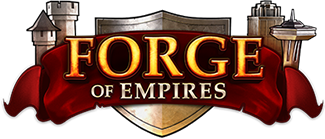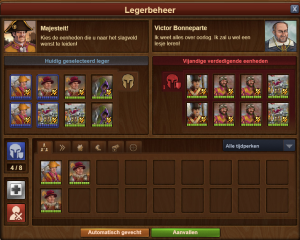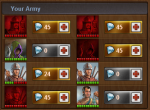Leger en gevechten
Wie een Koninkrijk wil bouwen zal moeten vechten. In Forge of Empires speelt het leger een belangrijke rol. Je kunt je eenheden gebruiken om andere spelers aan te vallen of provincies te veroveren op de Continenten kaart. Om te kunnen gaan vechten zul je eerst eenheden nodig hebben. Je rekruteert deze in een plaats in je militaire gebouwen. In Legerbeheer, beheer je de eenheden en voeg je ze toe aan je aanvallend leger of je verdedigend leger.
Legerbeheer
Het legerbeheer scherm is een efficiënte manier om je eenheden te managen. Je kunt eenheden markeren die je stad verdedigen, dezelfde eenheden kunnen zelfs gebruikt worden bij aanvallen.
De eenheden blauw gemarkeerd zitten in je verdedigend leger en verdedigen je Stad. Je moet altijd proberen om zoveel mogelijk eenheden in je leger te hebben. Medespelers moeten deze verslaan wanneer ze je aanvallen. Maar wees niet bang: zelfs als je tegenstander zegevierend is, zullen al je verdedigers weer genezen en nieuw leven ingeblazen worden tot volle sterkte direct na een gevecht waarbij je stad is verdedigd.Als je een andere speler wil aanvallen of een vijand op de Continentenkaart, kun je de aanvallende eenheden kiezen van je leger voordat het gevecht begint. Deze eenheden kunnen dezelfde zijn als de eenheden die je hebt gemarkeerd als verdedigende eenheden van je stad. Echter, je eenheden zijn niet beschermd wanneer je aanvalt en kunnen daardoor worden vernietigd of beschadigd... dus wees voorzichtig!
Tot slot, als je meteen naar de resultaten wilt gaan van het gevecht dan kun je dit doen door de knop "automatisch gevecht" te gebruiken in het Legerbeheer scherm. Houd in gedachte dat de AI de controle overneemt van je eenheden en dit geval en je zelf geen zetten kunt plannen van je eenheden!
Unit Types
Movement and Attack
The battle is fought in rounds. Basically, each unit moves and attacks once per round. They move according to their movement points, but each type of terrain will cost a differing amount. Directly after movement, if there is an opponent within their reach, the units can attack. Melee and fast units have to attack into an adjacent field, while ranged units can shoot at an enemy within their range.
There is no retaliation to fear from ranged attacks; however, in close-ranged battle, attacked fast and melee units can defend themselves. It works like this: First, the attacker does its damage, then the one being attacked hits back. However, there is only one counter-attack per round: even the strongest unit can be defeated by a swarm of enemies this way.
Damage
Each unit has a maximum of ten life points. The amount of damage points an attack deals is calculated using the current life points and the attack value of the attacker, the defense value of the attacked, modifiers for terrain, other bonuses (some units get bonuses if they fight against units of a particular type) and a random factor. Thus, a unit with a high attack rating deals more damage, and an uninjured unit inflicts more than a wounded one. On the other hand, high defense means good armor – the unit takes less damage. If a unit loses all its life points, it is destroyed.
Terrain
On the battle map, there are different types of terrain. Forest, bushes, rocks, small hills, plains and swamps are some of them. Terrain has two different effects in the game: Firstly, it affects movement. Water areas are impassable, and other types of terrain costs extra movement points when they are crossed. On the other hand, terrain can give battle bonuses: light melee units get defense bonuses in bushes and forests, heavy melee units are better protected in plains, long-range units receive an attack bonus when they shoot from hills, whereas those with short range attacks deal more damage standing on rocks. Only fast units do not receive benefits through the terrain.
Buffs
The stats of units might get further influenced by a percentile boost. While on some provinces of the Continent map all enemy units in it gain a percentage bonus to their attack and defense stats (easily seen in the sector view as small shield icons on top of the unit images), there are two different buffs that can affect the armies of the players, both of which are accumulated from certain buildings like a few of the Great Buildings:
- Fierce resistance: All units in the defending army of this player get a bonus to both their attack and defense stats, which means they take less damage and deal more.
- Military boost: All units in the attacking army of this player get a bonus to both their attack and the defense stats, which means they take less damage and deal more.
- Defense bonus: All units in the defending army of this player get a bonus to only their defense stat, which means they take less damage.
- Attack bonus: All units in the attacking army of this player get a bonus to only their attack stat, which means they deal more damage.
Special Skills
Healing
Is the battle over and your units have been damaged? No problem – they heal automatically over time, one life point at a time. Units that were destroyed in battle do not heal. Their corresponding slot in military building is freed again and you can recruit a new unit there.
You also have a possibility to heal your units in your Army Management screen using Diamonds.
You have a chance to resurrect a fallen unit right after a battle, using Diamonds. It can be worthwhile, especially if you've lost "unattached" units that are not from slots in military buildings but obtained through quests or events - a unit that you can't replace otherwise.




